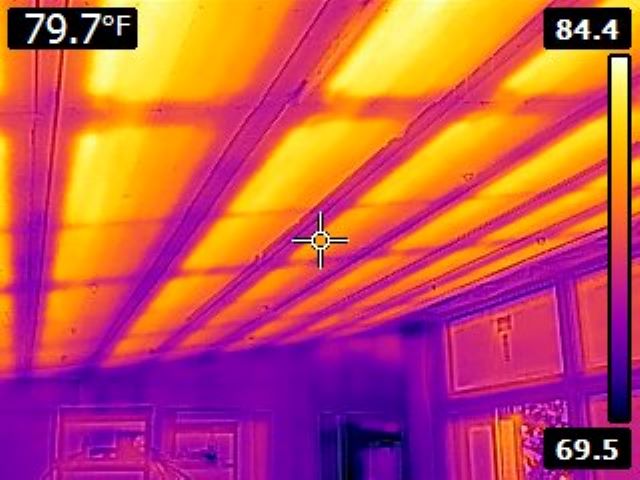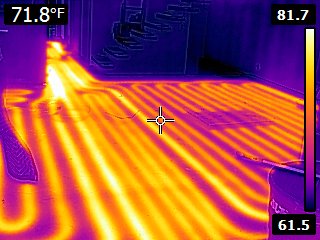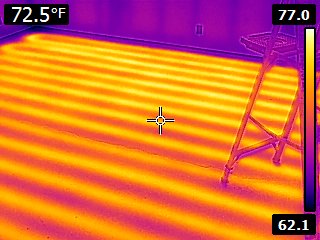Understanding "Radiant Heat"
Radiant heat is the transfer of thermal energy through electromagnetic waves, which is one of the three primary methods of heat transfer – the other two being conduction and convection. Unlike conduction, which requires contact between objects, or convection, which involves the movement of fluids or gases, radiant heat transfers through empty space.
The laws of thermodynamics govern this process and state that:
“Heat always moves from warmer bodies to cooler ones when a temperature differential exists.”
You can observe this principle in everyday occurrences, such as an ice cube melting under the sun’s rays.
The Warmth of Nature
People often compare radiant heat to the warmth you feel from the sun on a sunny day - direct and comforting!


Radiant Heating in HVAC
In the context of Heating, Ventilation, and Air Conditioning (HVAC), “radiant heat” or “radiant heating” represents a technology that harnesses the principle of infrared radiation to deliver warmth directly to the objects and occupants in a room.
These systems emit heat from surfaces like ceilings or floors, reminiscent of the warmth from the sun or a nearby fire. In contrast to traditional methods that primarily focus on heating the air, this approach targets people and objects directly, offering a more energy-efficient solution.
Types of Radiant Heating Systems
Radiant heating can be implemented in two primary ways:
- Electric
- Hydronic
Electric Radiant Heating
Electric radiant heating utilizes electricity to heat thin, resistant wires often embedded in electric mats. These mats are typically installed beneath flooring materials like tiles, wood, or laminate.
While easy to install and control, these systems are are less energy-efficient, making them more expensive to operate compared to their hydronic counterparts, especially in larger spaces. They are commonly employed in bathrooms, underneath tiles, more for their warm floor functionality than for overall heating.
Hydronic Radiant Heating
Hydronic radiant heating involves a closed-loop PEX tubing system that circulates heated water.
Contractors install this system within the floor or ceiling of a building.
Hydronic System Efficiency
Above all, hydronic systems are highly efficient. Water has a much higher thermal capacity than air, which means it can store and transport heat more effectively. A hydronic system only requires a small pump to move the heated water through pipes, unlike traditional HVAC systems that use a large fan and ductwork, which can result in heat loss.
Hydronic Radiant Ceiling Heating


Radiant ceiling panels, are commonly used for ceiling installations. These panels are seamlessly integrated into the ceiling structure and typically covered with drywall, preserving the aesthetics of the room.
Additionally, as the heat radiates from the ceiling, it encounters fewer obstructions and provides a larger, unobstructed radiant surface. Importantly, radiant heat, being an electromagnetic phenomenon, travels downwards effectively, ensuring a comfortable, well-heated space regardless of the ceiling height.
Messana Ray Magic® NK radiant ceiling panels
High-efficiency radiant ceiling panels, such as Messana Ray Magic® NK, deliver excellent heat transfer and outperform many other ceiling systems in both energy efficiency and overall performance. Additionally, these ceiling panels excel in radiant cooling applications.
Hydronic Radiant Floor Heating


Hydronic contractors implement hydronic radiant floor heating through several methods, including floor panels, underfloor tubing, concrete-based systems, or a gypsum pour (gypcrete).
Radiant floor offers the comfort of warm floors underfoot, an especially appreciated feature in bathrooms and other tiled spaces. However, it’s important to note that floor installations may limit flooring choices due to heat conductivity considerations and limitations on maximum floor temperatures for certain materials, such as wood.
Furthermore, the added thermal mass of certain systems or materials, such as concrete, gypcrete, tiles, or stones, can make the system slower to react compared to ceiling installations. This responsiveness may be an important consideration depending on your heating needs and lifestyle.
Radiant Floor Panel Systems
Radiant floor panels deliver heat faster and more efficiently than most other radiant subfloor delivery systems. For a particularly effective option, explore the floor panel system offered by our partner, WBI. It's exceptionally suited for radiant cooling and heating applications using Messana Controls.
Conclusion
Radiant heating systems, whether electric or hydronic, ceiling or floor, offer a unique comfort unmatched by traditional HVAC systems. In essence, by directly warming people and objects, radiant heating provides a consistent, comfortable heat that closely mimics natural solar radiation.
Finally, at Messana Hydronic Technologies, our team of experts specialize in designing hydronic radiant cooling and heating systems. We’re here to help you navigate the options and determine the best solution for your specific needs and space.
Interested in learning more?
We offer a free consultation and free estimate. Without delay, get a free estimate from our team today!
Hydronic radiant cooling and heating systems are an investment in comfort and efficiency, providing you with a superior heating solution. Trust Messana to guide you on this journey to ultimate indoor comfort.